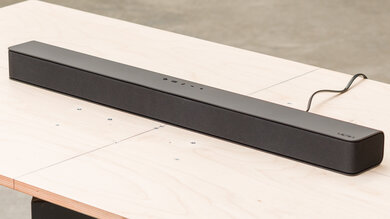The Vizio V Series V214x-K6 is a budget-friendly 2.1 model released in 2022. It has a similar design to last year's Vizio V Series V21x-J8, with an input that lets you pair third-party voice assistant devices so you can control the bar with your voice. Compared to the previous model, it's a bit smaller, too, which is great if you don't have a lot of space in your setup. That said, unlike the more premium offerings in the manufacturer's M Series, there's no Dolby Atmos support, and you don't have satellites on hand to improve its surround sound.
Our Verdict
The Vizio V Series V214x-K6 is fair for mixed usage. This 2.1 soundbar is ideal for listening to stereo content, which includes most music and TV shows. Out-of-the-box, it offers a balanced sound that ensures voices and instruments in your favorite songs are clear and present, and you don't have any trouble making out dialogue in TV shows. There are some customization tools on hand, though not as many as more premium models. It's not as great for watching movies, though, as the bar can't handle more advanced formats like Dolby Atmos that are increasingly popular on various streaming platforms.
- Bass and treble adjustments.
- Gets loud.
- Downmixes surround sound.
- No Atmos support.
The Vizio V Series V214x-K6 is good for dialogue-centric like TV shows and podcasts. It's a 2.1 bar, so it doesn't have a discrete center channel to improve vocal clarity, but you can still follow along with the dialogue on screen thanks to its balanced and even reproduction of vocals. Also, its Dialogue preset doubles as a dialogue enhancement feature to make voices more clear in the mix. If you like to listen to podcasts and audiobooks, you can stream them from your phone to the bar over Bluetooth, but unfortunately, there's no Wi-Fi support.
- Dialogue enhancement mode.
- Bluetooth support.
- No Wi-Fi, Apple AirPlay, or Chromecast.
The Vizio V Series V214x-K6 is satisfactory for music. It offers a somewhat balanced sound, especially in the mids, where most vocals and lead instruments reproduce. As a result, it's suitable for listening to lots of different genres, and you can even use its bass and treble adjustments to switch up its sound. That said, despite the included subwoofer, you notice a lack of low-bass, especially with bass-heavy genres like EDM and hip-hop.
- Bass and treble adjustments.
- Gets loud.
- Lacks some low-bass.
- No Wi-Fi, Apple AirPlay, or Chromecast.
The Vizio V Series V214x-K6 is middling for movies. It's a 2.1 bar, so it's mostly designed for listening to stereo content. It can't playback more advanced audio formats like Dolby Atmos, which are commonly found with movies on many streaming platforms. Similarly, 5.1 surround sound formats like Dolby Digital are downmixed into stereo with the bar, which takes away from the overall immersive feel. You don't notice a lot of rumble in your seat during intense scenes, but dialogue and other sound effects remain pretty clear in the mix.
- Gets loud.
- Dialogue enhancement mode.
- Lacks some low-bass.
- Downmixes surround sound.
- No Atmos support.
Check Price
Differences Between Sizes And Variants
The Vizio V Series V214x-K6 is available in Black. You can see the label for the model we tested here.
If you come across another version of this soundbar, let us know in the discussions, and we'll update our review.
Compared To Other Soundbars
The Vizio V Series V214x-K6 is a simple 2.1 bar available at a budget-friendly price. It's ideal for listening to stereo content like music and TV shows, as it lacks support for more premium audio formats like Dolby Atmos. There are basic sound enhancement features on hand, which is typical for products at this price point.
See also our recommendations for the best soundbars, the best soundbars for dialogue, and the best soundbars with a subwoofer.
Depending on your listening habits, you may prefer either the Vizio V Series V21x-J8 or the Vizio V Series V214x-K6. They're both budget-friendly 2.1 soundbars with similar designs. The V214x-K6 has a more balanced sound profile out-of-the-box, and it's a bit smaller overall. Its smaller design means that its soundstage isn't quite as good as the V21x-J8, which also offers HDMI inputs.
The Vizio M Series M215a-J6 and the Vizio V Series V214x-K6 are both budget-friendly offers available at around the same price. However, the M Series is more versatile overall. Unlike the V Series, it supports Dolby Atmos content, though it has to downmix it into stereo to play it. It has a better soundstage, plus HDMI inputs, meaning you can use HDMI CEC support with your TV remote.
The Samsung HW-B450 and the Vizio V Series V214x-K6 are both very similar 2.1 setups. They're available at budget-friendly prices, along with subwoofers to improve their bass reproduction. The Samsung soundbar's stereo soundstage is better; however, the Vizio gets a bit louder. Neither bar supports Dolby Atmos content, unfortunately.
Test Results

The Vizio V Series V214x-K6 has a similar design to the Vizio V Series V21x-J8, but it's a bit smaller. It's mostly made of plastic, with fabric covering the front and the sides. The controls are on top of the bar, while the inputs are on the rear.
The sub looks similar to the model that comes with the Vizio V Series V21x-J8. It's made of melamine and sits on four plastic pegs with rubber grips to keep it in place. The port is located in the rear, and the speaker is underneath.
The Vizio V Series V214x-K6 has a decent build quality. The bar is made of solid-feeling plastic, and the subwoofer's melamine build is quite sturdy. That said, the fabric on the bar itself isn't very tight, so be careful when handling it to avoid rips or tears. Also, it's prone to collecting dust and pet hair over time.
The Vizio V Series V214x-K6 has a good stereo frequency response. It performs well for such a budget-friendly bar, with a fairly even sound profile that ensures dialogue in TV shows, as well as vocals and instruments in your favorite music, are clearly and accurately reproduced. Though its sub can reproduce a decent amount of bass, you notice the lack of low-bass, especially with bass-heavy genres like EDM and hip-hop.
You can customize the bar's sound a bit thanks to its bass and treble adjustments. If you want a more balanced sound with stereo content, you can set its bass to '-1' and its treble to '1', which results in a clearer reproduction of voices, instruments, and other sound effects.
The bar's soundstage is fair with stereo content. In our testing room, it seems that the soundstage stretches a bit wider than the bar itself, but since the bar isn't very wide to begin with, it isn't much compared to models like the Vizio V Series V21x-J8. Its focus is pretty good, too, so you get a good sense of where various instruments are located in the soundstage around you. However, they seem to come from more general areas as opposed to accurate, pinpoint locations.
The Vizio V Series V214x-K6 gets pretty loud, so you don't have any trouble filling larger, more open spaces with sound. There's a bit of compression when you push it to max volume, but it's not very noticeable, especially if you prefer to listen at more moderate volume levels.
At normal listening volumes, the bar's distortion falls within good limits. As a result, audio reproduces with clarity and purity. Like most bars, you see a slight jump in THD when you push the bar to max volume. However, distortion is hard to hear with real-life content, so it isn't much of an issue unless you like to listen with the volume cranked up.
The Vizio V Series V214x-K6 is a 2.1 soundbar, so it doesn't come with a discrete center channel. Instead, it uses its left and right stereo channels to simulate a sound in the center. Voices are still very clear and easy to follow, even though the channel's sound profile isn't the most even. However, you don't get the same clarity as with bars with discrete center channels.
As with most 2.1 bars, the Vizio's surround sound performance isn't very impressive. It has to downmix 5.1 surround content like Dolby Digital to stereo to play it, which reduces the overall feeling of immersion. For example, in a chase scene, it doesn't really seem like cars race past you. Instead, sound is focused to the space in front of you.
The Vizio V Series V214x-K6 offers the same selection of sound enhancement features as the Vizio V Series V21x-J8. It's pretty good for a budget-friendly bar, as you can switch up its sound with bass and treble adjustments or its various preset modes: Movie, Music, Dialogue, and Game. On the remote, you can use the TVOL button or hold the subwoofer level button to activate auto-volume mode or the VRT:X button to turn on virtual surround. There's audio feedback to help you follow along as you switch these settings.
You can connect the bar to your TV over Optical. It's suitable for listening to different audio content, but since there are no HDMI ports, you can't use HDMI CEC to control the bar with your TV's remote.
Over Optical, the bar can playback Dolby Digital content. It's a common surround sound format found on many different streaming platforms. Although, since it's a 2.1 bar, it has to downmix it into stereo. When you watch content that isn't supported, like DTS, the bar lets you know via audio feedback.
While the bar has fairly high latency over Optical, the delay between the audio you hear and the video you see isn't very noticeable. Even with dialogue-centric content, you don't notice much issue with lip-synching unless you focus on it. Of course, different apps and TVs compensate for latency differently, so your experience can vary.
You can wirelessly stream audio to the bar from your mobile devices over Bluetooth.







































